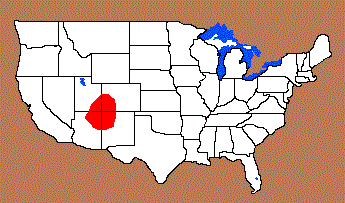Outline is Representative of Size and Shape:

Name Details:
Identified By: Cynthia Irwin-Williams
Named For:
Date Identified: 1973
Type Site:
Identified By: Cynthia Irwin-Williams
Named For:
Date Identified: 1973
Type Site:
Point Validity:
Valid type
Irwin-Williams was a distinguished Anthropologist who did extensive work in Colorado and the surrounding region. The studied, identified, and named the Picosa Archaic Culture which includes the Pinto, San Jose and the Cochise traditions. This point was named in a professional publication and has many professional references. This is considered a valid type.
Irwin-Williams was a distinguished Anthropologist who did extensive work in Colorado and the surrounding region. The studied, identified, and named the Picosa Archaic Culture which includes the Pinto, San Jose and the Cochise traditions. This point was named in a professional publication and has many professional references. This is considered a valid type.
Armijo
AKA: Grants (Berry, 1987)Cluster:
Description of Physical Characteristics and Flaking Pattern:
This is a thin small to medium lanceolate auriculate point with a flattened to thin elliptical to plano-convex cross section. The blade is primarily excurvate and commonly serrated. The shoulders are usually weak and at an upward angle with an expanding stem. This point may have an auriculate appearance. The basal auricle are generally rounded with a concave base. Most examples have basal and hafting region grinding present. This point is manufactures with primary percussion flaking and finished with secondary pressure flaking which usually obscures the primary flaking forming a random flaking pattern.
Size Measurements:
Total Length - 14 to 32 mm, Stem Length - 6 to 11 mm, Blade Width - 12 to 20 mm, Base Width - 11 to 17 mm, Thickness - 4 to 7 mm
Total Length - 14 to 32 mm, Stem Length - 6 to 11 mm, Blade Width - 12 to 20 mm, Base Width - 11 to 17 mm, Thickness - 4 to 7 mm
Commonly Utilized Material:
Primarily obsidian followed by basalt and chert
Primarily obsidian followed by basalt and chert
Additional Comments:
These points were originally named by Cynthia Irwin-Williams in 1973, and were reexamined and redefined by Michael G. Landon in 2005. This type has proved to be problematic due to similarities to the hafting region as those seen in the Pinto and San Jose types. Some professionals do not recognize this as a true type instead classifying it as a San Jose variant.
Irwin-Williams (1973) points out that these points differ from the San Jose points in that these points have a wider shorter hafting region that commonly seen on the San Jose point. These points are more commonly serrated than the San Jose type.
Thoms (1977) notes that the maximum width of this point (14.52 mm mean) suggest that this point was used as an arrow, all other characteristics of this point suggest that it was used as a dart.
Claudia Berry (1987), refer to a similar point as Grants points. It has been suggested that they are the same point as the Armijo point.
These points were originally named by Cynthia Irwin-Williams in 1973, and were reexamined and redefined by Michael G. Landon in 2005. This type has proved to be problematic due to similarities to the hafting region as those seen in the Pinto and San Jose types. Some professionals do not recognize this as a true type instead classifying it as a San Jose variant.
Irwin-Williams (1973) points out that these points differ from the San Jose points in that these points have a wider shorter hafting region that commonly seen on the San Jose point. These points are more commonly serrated than the San Jose type.
Thoms (1977) notes that the maximum width of this point (14.52 mm mean) suggest that this point was used as an arrow, all other characteristics of this point suggest that it was used as a dart.
Claudia Berry (1987), refer to a similar point as Grants points. It has been suggested that they are the same point as the Armijo point.
Distribution:
Distribution Comments:
This point is primarily found in Anasazi inhabited regions of the Colorado Plateau of Utah, Colorado, Arizona, and New Mexico.
This point is primarily found in Anasazi inhabited regions of the Colorado Plateau of Utah, Colorado, Arizona, and New Mexico.
Age / Periods:
Date: 3,800 - 2,800 B.P.
Cultural Period: Late Archaic
Glacial Period: Neoglacial
Culture: Anasazi Culture
Date: 3,800 - 2,800 B.P.
Cultural Period: Late Archaic
Glacial Period: Neoglacial
Culture: Anasazi Culture
Age Details:
Other points in this cluster / Related / Associated Points:






